RIGHT TURN ONLY!!
RTO Panic!
by Carlo Santos,

So, I heard that Borders is having a 5-for-4 manga sale this month. Time to stock up for that incoming Naruto flood, don'tcha think?
BEAUTY POP
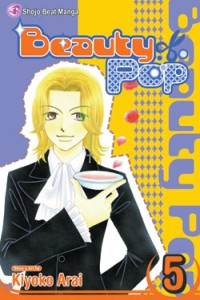
Vol. 5
(by Kiyoko Arai, Viz Media, $8.99)
FROM THE BACK COVER:
"Although a truly gifted hairstylist, Kiri Koshiba has no interest in using her talent to pursue fame and fortune, unlike the three popular boys in the 'Scissors Project' at school. Determined to become the best makeover team in Japan, they give showy makeovers to handpicked girls. As much as Kiri tries to shy away from the Scissors Project spotlight, she finds herself responding to beauty's call...
Narumi's father, Yujiro, a world famous hairstylist with salons across the globe, has never been able to defeat Kiri's father Seiji in a hairstyling competition. Will Narumi be able to surpass his father by winning against Kiri?"
EVIDENCE FOR:
Beauty Pop is at its best when the fires of rivalry burn hot, and this volume is no exception. The opening story is about Kiri accomplishing something that Narumi cannot, and you just have to marvel at her genius while acknowledging his jealousy. The real juicy stuff comes later on, though, when a key moment from Kiri and Narumi's past is revealed. Sure, the resolution is totally telegraphed, but the way it gets there is both intricate and hilarious. It takes no less than a discarded doll, a ratty old box, a really bad drawing, some Internet poking-around, and four schoolmates to find the truth about Narumi's most shattering childhood memory. And through it all, Kiri is still one of the most delightful (and underrated) heroines that the shoujo demographic has graced us with: calm, collected, loyal, and never afraid to speak the truth. Clean, delicate linework dominates the art as always—perfect for showing off those hairstyles—and the cute, distinctive character designs are instantly likeable.
EVIDENCE AGAINST:
Whatever it was that happened in the middle chapters, let us not speak of it again. The "kidnapping" incident in this volume is an ill-conceived space-filler, too ridiculous to be believable, and does nothing to further the story that we really care about: Kiri and Narumi's ongoing battle for hairstyling supremacy. Instead, this waste of two chapters is mostly a quibble involving side characters, and frankly, a lot of the side characters in the series are just lame. Can we write that fake-cute whineybag Chisami out of the story, please? The art has its weaknesses too, as the simple style makes it easy to spot the mistakes: skewed perspective, reduced or non-existent backgrounds, and covering up blank spaces with pointless tones and patterns. Layout is also something of a half-effort as panels and speech balloons end up scattered over the page with no real sense of flow—sure, the events are in order, but they don't guide the eye along.
FINAL VERDICT:
That ridiculous kidnapping plot really kills it in the middle, but the Kiri/Narumi back-story averages things back out to a C+.
DAZZLE

Vol. 6
(by Minari Endoh, Tokyopop, $9.99)
FROM THE BACK COVER:
"Razhel rescued the severely injured Alzeid from the clutches of deadly assassins, but he's going to lose his life anyway if they don't find a hospital fast! When the assassins catch up, Rayborn has to use all the tricks in the book to lure them away without getting himself killed. Who's behind the scenes pulling the strings in this most emotional volume of Dazzle yet?"
EVIDENCE FOR:
The fancily drawn characters draw you in, but it's the story that makes you stay. Dazzle has come a long way from its episodic road-trip beginnings, and the payoff finally arrives in this volume with a shocking event that affects all the main characters—even the emotionally distant ones. More than ever, there's a real sense of peril here: Rayborn fighting for his life to distract the assassins (but showing some real heroism along the way), Rahzel desperately trying to find a doctor to treat Alzeid, and even the roguish Baroqueheat putting his life on the line to make a deal with his antagonistic brother. And let's not forget the mysterious "monster" who's been teleporting around, terrorizing the town ... There are many, many plot threads floating about here, each one as compelling as the next, and really starting to pull the characters together. Amidst the drama there's plenty of time for action as well, and some of the most gripping moments are the ones where everyone's fighting to survive. A light sense of humor provides some balance—note Rahzel's funny cat-eared outfit, and the back-and-forth dialogue where even vicious fighters have time for snarky quips. But they key point to remember is that something happens in this volume that will change the story forever.
EVIDENCE AGAINST:
The number one side effect of multiple plot threads: confusion. It doesn't help that Minari Endoh is kind of a haphazard storyteller, jumping from one scene to another without warning—one moment we're in the thick of Rayborn's gunfight, then one page-turn later it's Rahzel dragging Alzeid through the streets. In the constant search for whichever moment is the most dramatic, the plot often forgets to slow down and let the reader re-orient. Even chapter breaks don't serve much of a purpose at this point; they basically just cut off scenes at certain suspenseful moments. Crowded layouts and dialogue also add to the confusion: with so much going on, one sees the side effects of trying to squeeze as much story as possible onto a page. Get ready for a lot of talking-head scenes (necessary for plot exposition), as well as overloaded multi-panel action sequences. There's just no visual continuity to the art—it's more like individual drawings showing what happens next. At least it's a very interesting, enticing what-happens-next.
FINAL VERDICT:
With a major turning point and lots of character drama in this volume, it's worth at least a B.
FULL METAL PANIC! (Novel)

Vol. 1
(by Shouji Gatou, illustrations by Shikidouji, Tokyopop, $7.99)
FROM THE BACK COVER:
"Jindai High School was a relatively safe place, right up until Sousuke Sagara transferred there. A total nut, he wreaks havoc on the school's student body and gets into a world of trouble with the teachers! But there's more to Sousuke than meets the eye—not just a hell-raising student, he's actually a member of an elite military unit, on an undercover mission to protect the beautiful schoolgirl Kaname Chidori from the KGB."
EVIDENCE FOR:
The Full Metal Panic! experience is like getting two stories for the price of one—at first, a fish-out-of-water high school comedy, and in the final two-thirds of the book, a tech-heavy action thriller. Disconnected as these genres might be, Shouji Gatou manages to make both of them work. The high school side delivers plenty of quick-paced slapstick, and for a guy with almost no personality, Sousuke is surprisingly funny—mostly because of his absolute literalism and lack of social graces. Once the action side kicks in, you can also add tension to the already fast pace; nothing says nail-biting thriller like a hostage situation. No matter what stage the story's at, there's always the teetering feeling that our hero is just one mistake away from death ... and the only way to ensure his survival is to keep on reading. The best action is saved for last, with a series of rapid-fire mecha battles that culminates in Sousuke going one-on-one against a superterrorist, equipped with technology so advanced it isn't even supposed to be there. How's that for epic?
EVIDENCE AGAINST:
This adventure sure moves fast ... maybe too fast. Nothing is quite as disorienting as the incessant scene changes in the book—as soon one of Sousuke and Chidori's school escapades finds its rhythm, for example, suddenly we're cutting to What The Bad Guys Are Up To, or Meanwhile Back At Central Command. The short-attention-span scene transitions, along with a heavy emphasis on action and thrills, ultimately make this a shallow experience. Oh, there are some attempts at digging further into the characters and story, but all of them fall short—the sentimental moments between Sousuke and Kaname are too brief and artificial, and a brief discussion of "Black Technology" near the end is just a half-hearted scratch at the story's sci-fi surface. The simple writing style isn't very enticing, either; there are times when the narration reads more like a military news report than actual storytelling. It's fast, it's fun, but it feels like substance and style both went on vacation for this one.
FINAL VERDICT:
Although it's loaded with thrills and action, this novel is the kind best enjoyed at the airport. A fluffy plot and bland writing push it to about a B-.
HEAVEN!!
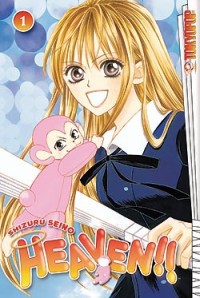
Vol. 1
(by Shizuru Seino, Tokyopop, $9.99)
FROM THE BACK COVER:
"Rinne is a girl who not only can see ghosts, she can exorcise them—with a paper fan! When she's saved from becoming a ghost by the school punk, he ends up in a coma. Fortunately, that doesn't stop their unique relationship from forging: Rinne and her rescuer's now-disembodied spirit must defend his prone body from being possessed by a muddled collection of local ghosts. When Rinne fails in her task, an ancient playboy takes over the punk's body—leaving him to inhabit a pink stuffed monkey! In this madcap adventure, what's a girl to do?!"
EVIDENCE FOR:
Spirits be praised! A supernatural-themed story that doesn't involve episodic detective tales? Heaven!! is a much-needed slap in the face, elbow to the ribs, and kick in the nuts for a highly predictable genre. Volume 1 gets off to a rip-roaring start, with comic violence on almost every page, and by the end of the first chapter, we've already got the two main soul-switches in place—school punk Uzaki inside a stuffed monkey, and philandering god Keiju in Uzaki's body. Naturally, this opens the door for comedy galore: Uzaki-possessed-by-Keiju shows up the next day as a preening bishounen, much to the delight of the school's female population and the horror of Rinne. Slapstick reigns as well, with a madcap river rescue that involves monkey-possessed-by-Uzaki hitching a ride on a dog. Seriously. Of course, we can't forget Rinne either, who leads the way as a strong-willed, smart-talking character: got to love a heroine like that. It's nonstop energy from start to finish, and the quick pacing—Will Keiju get out of Uzaki's body? He does! Oh wait, he's back in again—promises plenty of wild, unpredictable laughs.
EVIDENCE AGAINST:
Sure, it's a wild, laugh-a-minute romp—but that kind of humor can be overpowering when it dominates an entire volume. This one feels like endless noise and silliness, and while the gags are definitely fun, they all start to blur together because there's no downtime to space things out. One moment you're seeing Rinne beat up on possessed-Uzaki, and then the next moment she's ... beating up on him again. The artwork has that overpowering loudness as well, with its constant stream of speedlines and pratfalls and crazy reaction faces. It's like no one ever gets a chance to just relax. The character designs and style aren't all that remarkable, either; they're just enough to tell the story, but lacking in strong visual qualities. Good thing the characters have wacky personalities, because no one's going to remember them for their looks. So enjoy this one as riotous popcorn entertainment, but realize that it doesn't have much substance behind it.
FINAL VERDICT:
Just for putting a farcial spin on the gods-and-spirits genre—and, you know, having a stuffed monkey toy possessed by a delinquent—this one deserves a B.
SHIKI TSUKAI
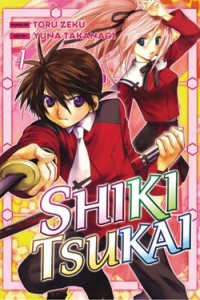
Vol. 1
(by To-ru Zekuu and Yuna Takagi, Del Rey, $10.95)
FROM THE BACK COVER:
"On the day he turns fourteen, Akira discovers his destiny: he's a shiki tsukai, a warrior with the magical power to control the seasons. He also meets the beautiful Koyomi, another warrior, who is sworn to protect him. For there are evil forces intent on destroying Akira—and the entire universe!"
EVIDENCE FOR:
The best thing Shiki Tsukai's got going for it is an elaborate, highly original concept—who knew that the traditional Japanese calendar was so loaded with folklore and mysticism? One might even imagine the creators drawing up some massive chart of spells, elements, and seasons, all of which add up to a grandiose battle system that incorporates birthdays, feast-days, spellcasting, summonable monsters, and—believe it—collectible cards. When this battle system comes to life, that's when the series starts to shine: this volume is meticulous about including at least one fight per chapter, as a showcase for fancy seasonal attacks (think ice storms and sakura swirls), as well as fearsome, intricately drawn beasts (like giant snakes). Panels shift in size to accommodate the grand scope of these battles; it's not unheard of to see a really good attack take up an entire page. The quick, action-focused pacing and straightforward story make it easy to get caught up in this adventure, and with 365 days of the year to draw folklore from, the possibilities are wide open.
EVIDENCE AGAINST:
No ... seriously ... is this some kind of joke? Card dueling with the power of the seasons? Do people just walk into toy stores and game arcades to pick up manga ideas now? While the idea is pretty original, the delivery is anything but—it centers around a 14-year-old boy (yawn) with a special, destined power (snore) that must be protected by a strong female character who happens to know everything about this secret world (instant coma). Koyomi's role as a walking reference manual becomes especially tiresome when she starts explaining how the cards work and the pages start looking more like a gaming guide than a comic. This plot moves in the most mechanical way possible—please, spare us the euphemism of "straightforward"—as Akira's entire character arc consists of him learning needlessly complex spells and incantations. Even the visual effects are mired in cliché: combatants setting up "closed spaces" for battle, speedlines and swooshes thrown haphazardly into every action scene, towering beasts battling each other in the sky, even a saucy transformation sequence for Koyomi when Akira activates her power. Somehow, it's very fitting that the generic-looking characters all have this dead look in their eyes, because behind this flash and bang is a lifeless husk of a story.
FINAL VERDICT:
It's hard to get excited for a series that reads like an ad for a card-battling game. Clever concept aside, it's just a D-grade story in search of a toy license.

VINLAND SAGA
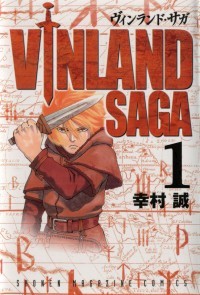
Vol. 1
(by Makoto Yukimura, Kodansha, ¥419)
SUMMARY:
"Thorfinn is a young man traveling with a band of Vikings, led by the fearsome warrior Askeladd. But Thorfinn's motives involve more than just looting and plunder: Thorfinn wants revenge, for Askeladd killed his father years ago. That's not Thorfinn's only childhood memory, either—he's also heard of a place called Vinland, far beyond the western seas, a land of peace and abundance. Perhaps in Vinland he can finally escape the strife that has plagued him since childhood."
EVIDENCE FOR:
In the endless debate between pirates, ninjas and robots, Vikings might secretly have the edge. Vinland Saga oozes with hot-blooded manliness, and not of the cheesy "I'm gonna get stronger!" variety, but the kind where people get their eyes pierced, shoulders dislocated, and heads cut off. Madness? This is Denmark! (Even though the bulk of the action in Volume 1 happens in France, plus an extended flashback to Iceland.) Brutal combat scenes are most stunning parts of the series so far, with rich details bringing each moment to life: massive ships plowing the waters, hundreds of dead bodies after a Viking rampage, the sweeping landscapes of medieval Europe. The grand battles also have a natural flow to them, never losing track of what's going on: amidst all the ruckus, that one page where Thorfinn goes after an enemy general's head is the very definition of cinematic. Yet Yukimura can touch on sensitive matters as well, as shown in the flashback to Thorfinn's childhood. This is where the storytelling really shines, with tales of youthful curiosity and noble sacrifice. And just look at the expressions and details on characters like Leif Ericsson or Thorfinn's father—who knew that there was a manga artist out there who could draw characters over the age of 20? This is the kind of talent that is not to be missed.
EVIDENCE AGAINST:
Even great talents have weaknesses, and clearly, Makoto Yukimura has no idea what to draw during dialogue scenes. The writing may be excellent, but the visuals during these scenes are a drag, with page after page of perfectly rectangular panels aligned to a 3-row grid. Static layouts like these suck the momentum right out of the story—suddenly it becomes an exercise in watching people talk to each other and waiting for the next action scene to show up. The halfway shift to Thorfinn's childhood is also questionable, as it practically splits the first volume into two separate stories—surely the more logical thing would have been to introduce him as a child, and then jump forward to the action with the Viking clan? Well, that's what Volume 2 is for—to move ahead in the story and see what happens next.
FINAL VERDICT:
With its rich visual details, emotional pull and strong characters, this historical epic is an instant winner.
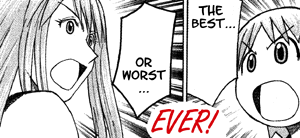
Let's get back to the good stuff! From the nichest of niche publishers comes one of the Best Manga I've Ever Read:
BLUE

(by Kiriko Nananan, Fanfare / Ponent Mon, $23.99)
Another reviewer somewhere may have once said that Blue is the kind of pseudo-literature that stuck-up manga nerds read to make themselves feel smarter and think it's soooo deep. That's probably true, but it doesn't stop me from enjoying the emotional impact of this single-volume work. Seriously, it's one of those "If you don't love this, you don't love yuri" titles that ranks right up there with Aoi Hana and is probably a notch above Kashimashi.
It walks down a familiar path of high-school romance, but does so with a quiet gracefulness. Kayako Kirishima and Masami Endo are two students at an all-girl high school who gradually come to like each other while experiencing the ups and downs of love—secrets, insecurities, jealousy, and having to face the future when school ends. The narrative is almost Impressionistic in style: little dots of story, short and simple conversations, adding up to form a portrait of two young women coming of age. The dialogue is sweet, honest, and often times heartbreaking—a gentle reminder that the same feelings that lift us up can also tear us down.
What's most remarkable is that Kiriko Nananan accomplishes all this with stark, simple art that is almost pure black-and-white. Even with the characters drawn as mere lineart, their expressions and poses say it all, and the sparse paneling—with lots of blank areas and silences—really gives the story room to breathe, to express the feelings that can't be said in words. So it really doesn't matter if you're a stuck-up manga nerd or a yuri lover or neither: just read Blue. (If you can find it. Good luck!)
discuss this in the forum (16 posts) |